|
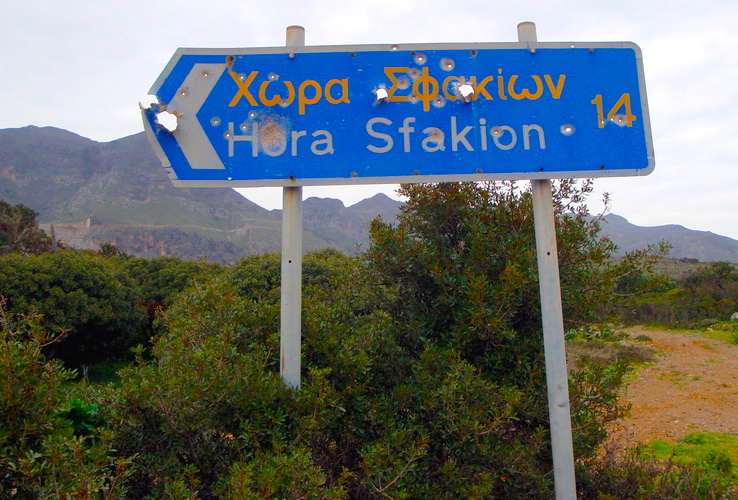 On your list of must-see areas is the region of Sfakia on the southern coast of Crete below Chania. Sfakia is to Crete as the Mani is to the Peloponessos. Its an area that most of those who invaded the island felt it was easier to leave alone then to try to conquer. Its men were tough, the land
was rugged
and to risk losing your army to invade an area that had little strategic value and inhabitants who would never submit peacefully was more trouble than it was worth. So the area stayed isolated and took on an identity separate from the rest of the island and also became a haven for people around Greece who needed to escape the authorities. When my grandmother's village of Kyparisi, known then as Kyfanta, was attacked by the Turks and most of the villagers murdered, the survivers came to Hora Sfakion where they
felt they would be safe. Though the area has now seen an invasion of tourists it is nowhere near the scale of the rest of Crete and the Sfakians still have the reputation of being fiercely independent, strong willed and willing to fight to the death if they have to. When you hear about the famous Cretan vendettas it usually has to do with families in Sfakia. On your list of must-see areas is the region of Sfakia on the southern coast of Crete below Chania. Sfakia is to Crete as the Mani is to the Peloponessos. Its an area that most of those who invaded the island felt it was easier to leave alone then to try to conquer. Its men were tough, the land
was rugged
and to risk losing your army to invade an area that had little strategic value and inhabitants who would never submit peacefully was more trouble than it was worth. So the area stayed isolated and took on an identity separate from the rest of the island and also became a haven for people around Greece who needed to escape the authorities. When my grandmother's village of Kyparisi, known then as Kyfanta, was attacked by the Turks and most of the villagers murdered, the survivers came to Hora Sfakion where they
felt they would be safe. Though the area has now seen an invasion of tourists it is nowhere near the scale of the rest of Crete and the Sfakians still have the reputation of being fiercely independent, strong willed and willing to fight to the death if they have to. When you hear about the famous Cretan vendettas it usually has to do with families in Sfakia.
|
|
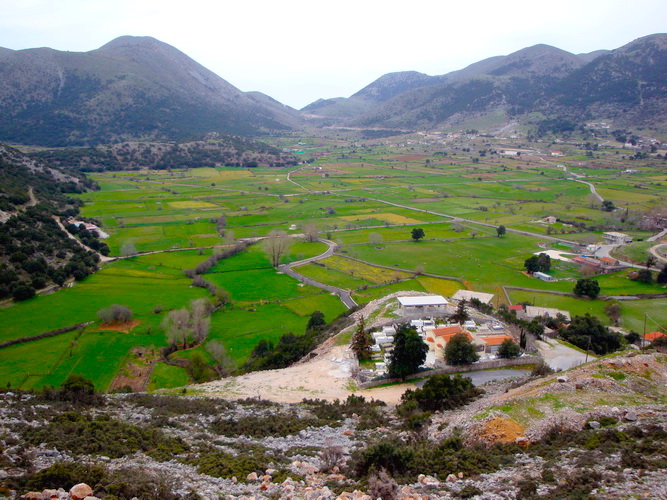 To get there from Chania you take the National Road east like you are going to Rethymnon and get off at Vrisses with the river that splits the town in half, lined on each side by cafes and a great place to stop for a coffee were it not just 20 minutes from Chania. That is easily remedied by skipping coffee and breakfast
and just
getting on the road right away since you will need the entire day anyway. The road climbs into the mountains past goats and sheep and suddenly you pass through the mountains and see before you a giant green high plain with farms, sheep, a village and the War Museum of Askifou, a place you have to stop and pay tribute to the late Mr. George A Hatzidakis who in his lifetime managed to collect and label every single item he could find that had everything to do with the German invasion, occupation and the
Cretan
resistance during the Second World War. From German and British helmets, machine guns, pistols, uniforms, canteens, the vintage guns the Cretan's used to fight the Germans, an anti-aircraft gun, a motorcycle like the one Steve McQueen rode in The Great Escape, medals, radios, nothing is considered too insignificant to have a place in the museum. To get there from Chania you take the National Road east like you are going to Rethymnon and get off at Vrisses with the river that splits the town in half, lined on each side by cafes and a great place to stop for a coffee were it not just 20 minutes from Chania. That is easily remedied by skipping coffee and breakfast
and just
getting on the road right away since you will need the entire day anyway. The road climbs into the mountains past goats and sheep and suddenly you pass through the mountains and see before you a giant green high plain with farms, sheep, a village and the War Museum of Askifou, a place you have to stop and pay tribute to the late Mr. George A Hatzidakis who in his lifetime managed to collect and label every single item he could find that had everything to do with the German invasion, occupation and the
Cretan
resistance during the Second World War. From German and British helmets, machine guns, pistols, uniforms, canteens, the vintage guns the Cretan's used to fight the Germans, an anti-aircraft gun, a motorcycle like the one Steve McQueen rode in The Great Escape, medals, radios, nothing is considered too insignificant to have a place in the museum.
|
|
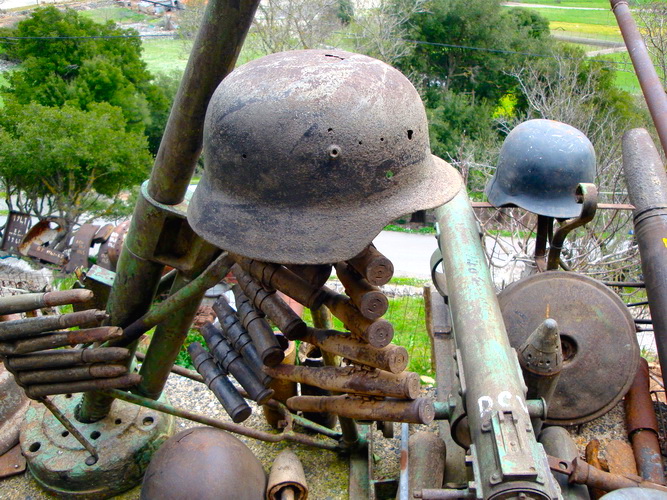 Hitler's invasion of Crete was a massive one. The island was defended by 40,000 British, Australian and New Zealand soldiers as well as the remnants of the Greek army which had escaped the mainland to Crete, most of them without their weapons. It was the largest
airborne invasion
ever and for the Germans it was the bloodiest with the first attackers sufferring casuatlies of 90% as allied soldiers and Cretan farmers simply shot parachutests out of the sky as they slowly decended. But with massive air-support and overwhelming numbers the Germans forced the allied soldiers to retreat through this area to the port of Hora Sfakion where they were evacuated to Alexandria, Egypt, leaving the Cretans and handful of intelligence officers to continue the resisitance. George Hatzidakis
was a child at the time and witnessed all of this, was wounded himself, saw several family members killed, and his museum is a tribute to those who died during the invasion and occupation. Though he has requested support from the Greek government for his museum, he has received none and it survives entirely on donations. The hand painted signs make it easy to find and it really is one of those hidden treasures of Crete that even some guidebooks have missed. Click here
for more on the War
Museum of Askifou. Hitler's invasion of Crete was a massive one. The island was defended by 40,000 British, Australian and New Zealand soldiers as well as the remnants of the Greek army which had escaped the mainland to Crete, most of them without their weapons. It was the largest
airborne invasion
ever and for the Germans it was the bloodiest with the first attackers sufferring casuatlies of 90% as allied soldiers and Cretan farmers simply shot parachutests out of the sky as they slowly decended. But with massive air-support and overwhelming numbers the Germans forced the allied soldiers to retreat through this area to the port of Hora Sfakion where they were evacuated to Alexandria, Egypt, leaving the Cretans and handful of intelligence officers to continue the resisitance. George Hatzidakis
was a child at the time and witnessed all of this, was wounded himself, saw several family members killed, and his museum is a tribute to those who died during the invasion and occupation. Though he has requested support from the Greek government for his museum, he has received none and it survives entirely on donations. The hand painted signs make it easy to find and it really is one of those hidden treasures of Crete that even some guidebooks have missed. Click here
for more on the War
Museum of Askifou.
|
|
Beyond Askifou is the entrance to the Imbros Gorge near the village of Imbros, yet another of the amazing cracks in the mountains that lead to the sea, this one 7 kilometers long and one of the tallest and narrowest, with many caves and lots of interesting vegetation and rock formations. From Imbros to the coast is only a three hour walk and passes through some Venetian ruins before ending at the village of Komitades which has the popular Porofarango
Taverna where
most people begin or end their trip since some people enter the gorge from here and walk upwards, if not the whole way at least some distance to get an idea of it.
|
|
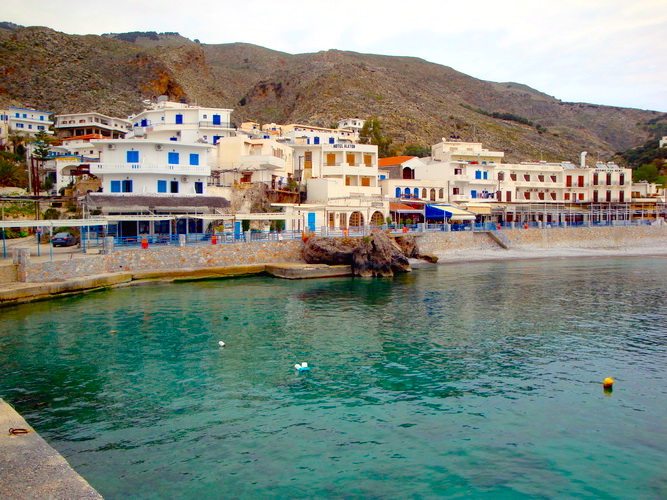 The village of Sfakia, known as Hora Sfakia which means 'village of Sfakia' is in a small identation in the mostly stone moutains that fall to the sea, the south side of the Lefka Ori. You approach it from a new modern road that winds down from the south side of the White Mountains after passing
through
much of the Imbros Gorge. This is where the boats from the Samarian Gorge end up so you get several thousand people a day passing through here though few end up staying in the village. Promoted as an escape from the mass-tourism of the north coast of Crete, there are a number of smallish hotels and several traditional Sfakian tavernas in the newly rennovated port, only one of which is open in the winter. Tourism is limited here but you will find a devoted group who come here every year and sing its
praises as one of the best places in Crete to escape the scourge of mass-tourism. Though our visit was in the winter with the sky gray and much of the town was shuttered, I can easily imagine spending a week or so here, and in Greece, once you have spent a week anywhere you will have made friends and probably return. As far as activities there are a couple nice beaches within walking distance or that you can get to by excursion boat or with Captain Yannis Water taxi who will take you as far as
Agia Roumeli and anywhere else according to the flyers posted in town. See Hotels in Hora Sfakia The village of Sfakia, known as Hora Sfakia which means 'village of Sfakia' is in a small identation in the mostly stone moutains that fall to the sea, the south side of the Lefka Ori. You approach it from a new modern road that winds down from the south side of the White Mountains after passing
through
much of the Imbros Gorge. This is where the boats from the Samarian Gorge end up so you get several thousand people a day passing through here though few end up staying in the village. Promoted as an escape from the mass-tourism of the north coast of Crete, there are a number of smallish hotels and several traditional Sfakian tavernas in the newly rennovated port, only one of which is open in the winter. Tourism is limited here but you will find a devoted group who come here every year and sing its
praises as one of the best places in Crete to escape the scourge of mass-tourism. Though our visit was in the winter with the sky gray and much of the town was shuttered, I can easily imagine spending a week or so here, and in Greece, once you have spent a week anywhere you will have made friends and probably return. As far as activities there are a couple nice beaches within walking distance or that you can get to by excursion boat or with Captain Yannis Water taxi who will take you as far as
Agia Roumeli and anywhere else according to the flyers posted in town. See Hotels in Hora Sfakia
|
|
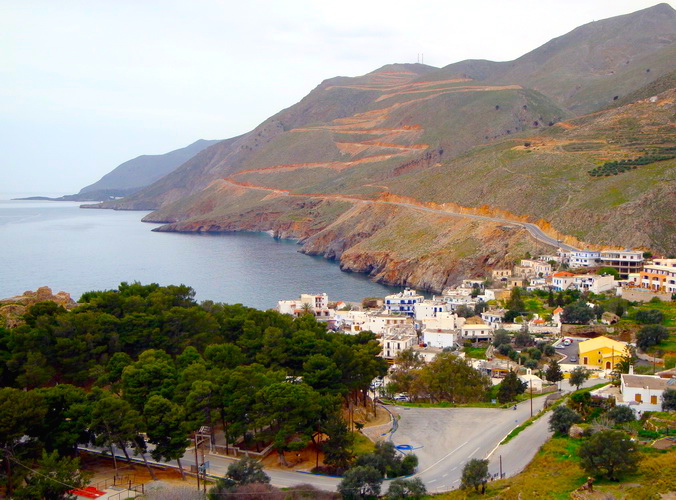 Walking trails lead all the way to Agia Roumeli and the entrance of the Samarian Gorge, going through the village of Annapolis, the site of Ancient Annapolis with its Cyclopian walls and remnants of the Romans and the Byzantines who lived here. It was a center of resiatance against
the Venetians
and in 1365 was destroyed and empty of its inhabitants until the Ottoman occupation. You can drive here and walk to the fishing village of Loutro, site of the ancient city of Phoenix which has several hotels and tavernas on one of the only natural harbors in southern Crete and is connected to Agia Roumeli and Hora Sfakion by boat. Kayaks are available to rent and those who are experienced can explore the southern coast of Crete. The ancient city of Araden is built on the edge of the Ardenas
Gorge and is reached by crossing metal Varinoyannis Bridge the highest bungee jumping bridge in Greece. The village which is said to have been founded by the Phoenicians is largely deserted now but has a Byzantine Church of the Archangel Michael, built in the 15th Century on the foundation of an earlier church from the 5th or 6th century. If you continue on to the village of Agios Ioannis there are two churches known for their interior frescoes. Walking trails lead all the way to Agia Roumeli and the entrance of the Samarian Gorge, going through the village of Annapolis, the site of Ancient Annapolis with its Cyclopian walls and remnants of the Romans and the Byzantines who lived here. It was a center of resiatance against
the Venetians
and in 1365 was destroyed and empty of its inhabitants until the Ottoman occupation. You can drive here and walk to the fishing village of Loutro, site of the ancient city of Phoenix which has several hotels and tavernas on one of the only natural harbors in southern Crete and is connected to Agia Roumeli and Hora Sfakion by boat. Kayaks are available to rent and those who are experienced can explore the southern coast of Crete. The ancient city of Araden is built on the edge of the Ardenas
Gorge and is reached by crossing metal Varinoyannis Bridge the highest bungee jumping bridge in Greece. The village which is said to have been founded by the Phoenicians is largely deserted now but has a Byzantine Church of the Archangel Michael, built in the 15th Century on the foundation of an earlier church from the 5th or 6th century. If you continue on to the village of Agios Ioannis there are two churches known for their interior frescoes.
|
|
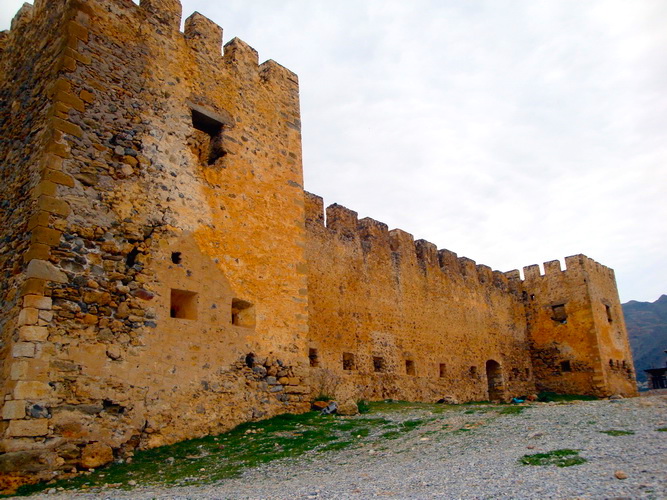 East of Hora Sfakion you pass through several villages that hug the mountainside before coming to a coastal plane and the town of Fragokastelo, named for the 14th Century fortress that sits above a sandy beach with a small settlement of rooms and tavernas. Its a
great place
for a swim, especially in the off season when it is not full of tourists and people who come from the north for the day, usally on weekends and in August. The castle itself is an interesting brown color and you can go inside and walk around, there is no admission charge and unlike most castles which are usually in defensive positions you don't have to climb to it. It sits in what in the summer must look pretty much like a parking lot and which in the early spring made me think "What a weird place for a castle".
Though built by the Venetians (anybody from Europe were Franks as far as many of the Greeks were concerned) as a defense against pirate incursions or to quell the rebelliousness of the locals, it was pretty much unused and for a time actually dismantled until the Ottoman occupation when it was the scene of a bloody battle between Cretan revolutionaries led by Dalianis, Tsouderos and Deliyanis against the Turkish forces in 1828. The area is supposedly haunted by the ghosts of these fighters whose
shadowy figures appear on foot and horseback every year at dawn on May 18th. See Hotels in Frangokastelo East of Hora Sfakion you pass through several villages that hug the mountainside before coming to a coastal plane and the town of Fragokastelo, named for the 14th Century fortress that sits above a sandy beach with a small settlement of rooms and tavernas. Its a
great place
for a swim, especially in the off season when it is not full of tourists and people who come from the north for the day, usally on weekends and in August. The castle itself is an interesting brown color and you can go inside and walk around, there is no admission charge and unlike most castles which are usually in defensive positions you don't have to climb to it. It sits in what in the summer must look pretty much like a parking lot and which in the early spring made me think "What a weird place for a castle".
Though built by the Venetians (anybody from Europe were Franks as far as many of the Greeks were concerned) as a defense against pirate incursions or to quell the rebelliousness of the locals, it was pretty much unused and for a time actually dismantled until the Ottoman occupation when it was the scene of a bloody battle between Cretan revolutionaries led by Dalianis, Tsouderos and Deliyanis against the Turkish forces in 1828. The area is supposedly haunted by the ghosts of these fighters whose
shadowy figures appear on foot and horseback every year at dawn on May 18th. See Hotels in Frangokastelo
|
|
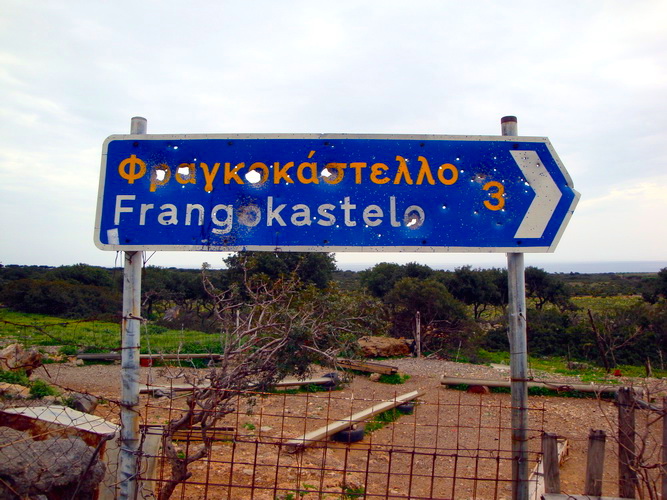 I don't think there is a road sign in the whole area that has not been shot up and if you stop to look at them closely and see how they have shot out the holes on the letter o, for example you have to wonder that if someone did this from a moving car (or pick-up truck most likely) no wonder the Germans
had such a hard
time in Crete. You can continue along the coast past the beach resort town of Plakias, (which looks like a really great place to stay in the summer so see Plakias Hotels) and the famous Moni Prevali, or do as we did and turn north to Rethymnon, a small fishing village half a century ago that is now a sprawling metropolis with a cafe lined coast,
a beautiful old town and and two notable attractions, an amazing 16th Century fortress overlooking the city, which should not be missed and white taxi cabs which must be a nuisance to keep clean. Almost everything you will
want to see is within walking distance of the Venetian harbor and many people who visit Crete make this their base. There is an Archaeological Museum, a Folklore Museum, the lion-headed Rimondi Fountain and various fountains, hamams, mosques and galleries. But for my money Chania is the place to stay and Rethymnon somewhere you can go on a daytrip since it is only about 45 minutes away. If you have time stop at Kournas Lake if you have not done so already. I don't think there is a road sign in the whole area that has not been shot up and if you stop to look at them closely and see how they have shot out the holes on the letter o, for example you have to wonder that if someone did this from a moving car (or pick-up truck most likely) no wonder the Germans
had such a hard
time in Crete. You can continue along the coast past the beach resort town of Plakias, (which looks like a really great place to stay in the summer so see Plakias Hotels) and the famous Moni Prevali, or do as we did and turn north to Rethymnon, a small fishing village half a century ago that is now a sprawling metropolis with a cafe lined coast,
a beautiful old town and and two notable attractions, an amazing 16th Century fortress overlooking the city, which should not be missed and white taxi cabs which must be a nuisance to keep clean. Almost everything you will
want to see is within walking distance of the Venetian harbor and many people who visit Crete make this their base. There is an Archaeological Museum, a Folklore Museum, the lion-headed Rimondi Fountain and various fountains, hamams, mosques and galleries. But for my money Chania is the place to stay and Rethymnon somewhere you can go on a daytrip since it is only about 45 minutes away. If you have time stop at Kournas Lake if you have not done so already.
You can do this itinerary from Chania with Dimitris the Taxi Driver or Heraklion with Lefteris the Taxi Driver if you don't want to rent a car.
If you are planning to stay in this area contact Fantasy Travel and ask about hotels in western Crete or see Matt's Hotels of Greece Crete Pages
|
|










